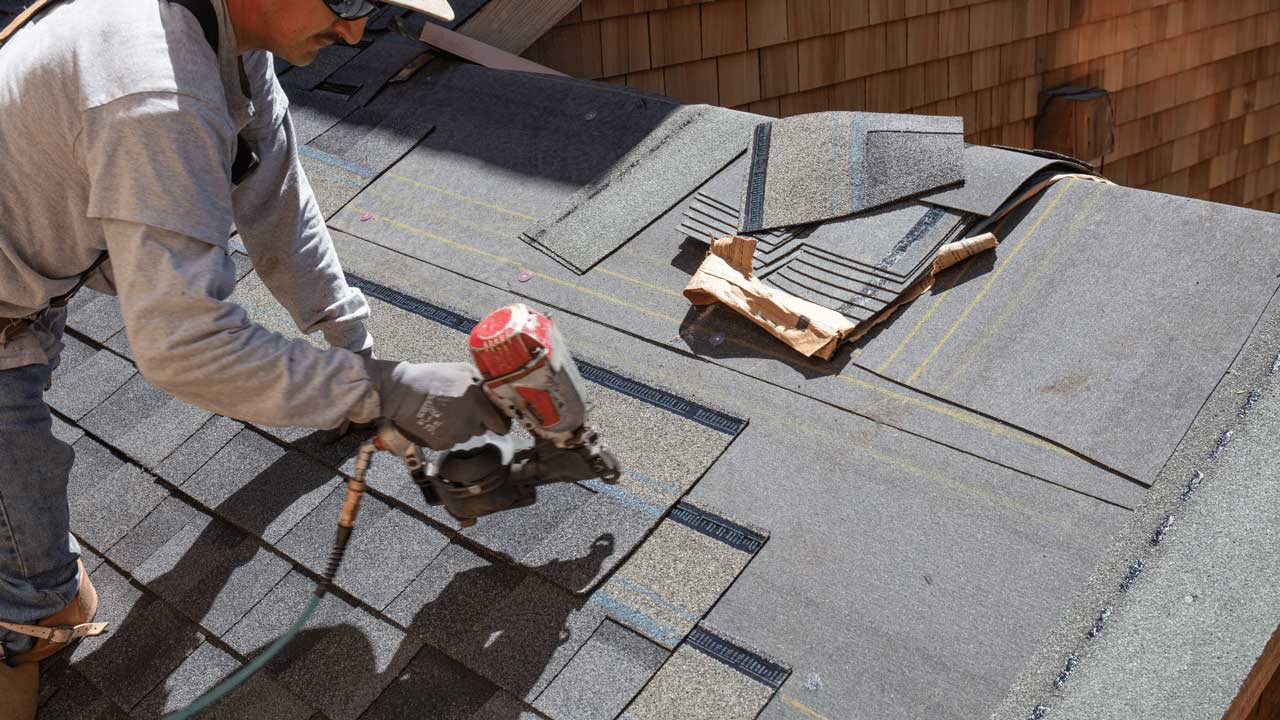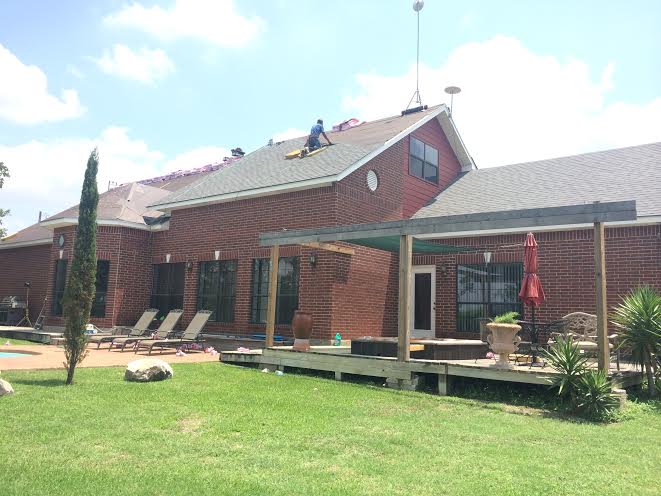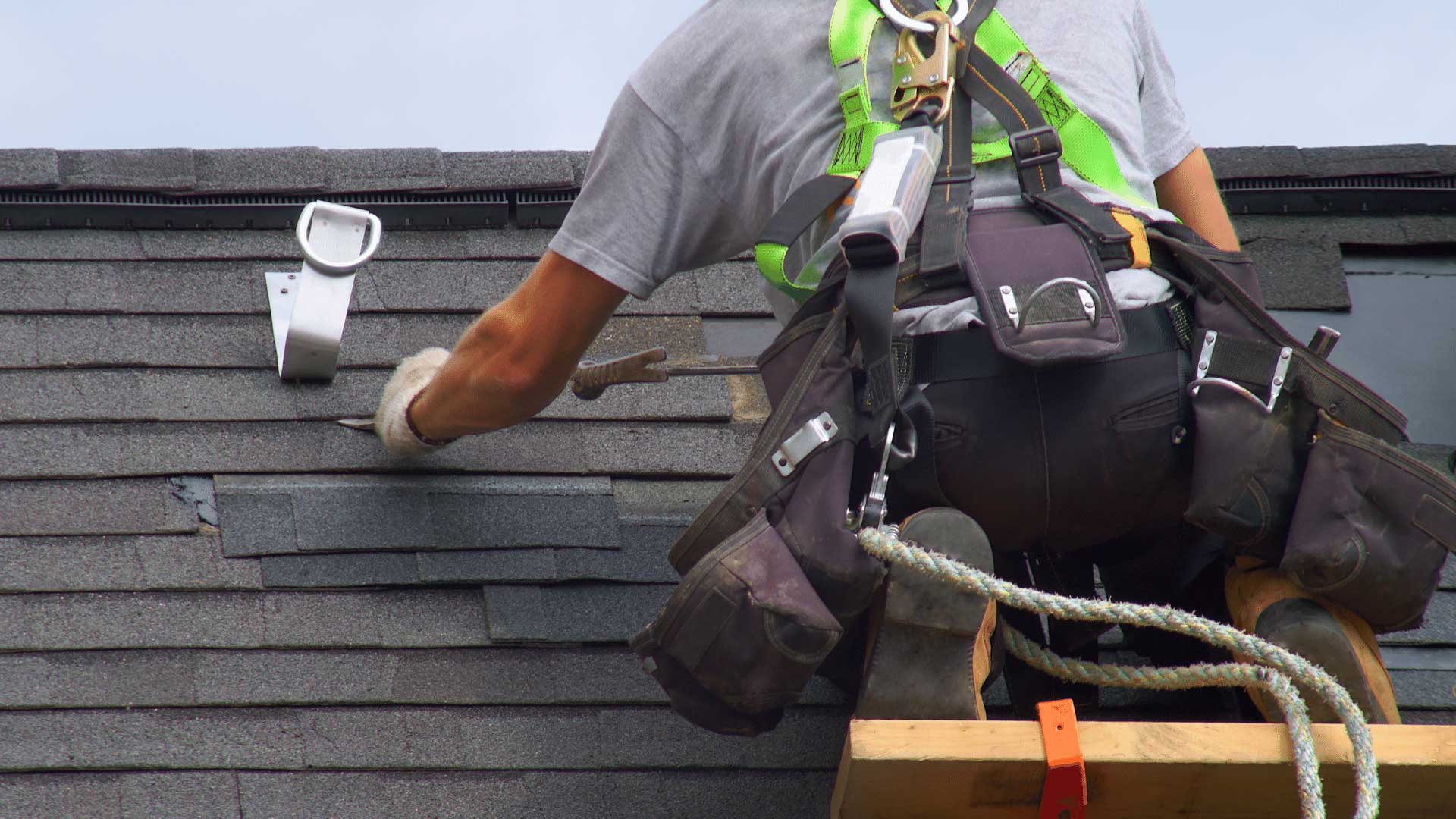Winter weather can cause a variety of issues when it comes to the exterior of your home. One such issue that can have serious consequences is ice dams, which form on roofs and can cause significant damage if left unchecked. In order to protect both their property and finances, homeowners must understand how ice dams form and what they can do to mitigate the risk. This article will explore the process of protecting one’s home from ice dam formation by discussing several preventative measures.
Ice dams occur primarily in regions with cold climates where snow accumulates on rooftops throughout winter months. As temperatures rise during the day, melting snow travels down towards eaves, creating pools of water along rooflines. If these pockets remain for long enough periods of time, temperature shifts at night may freeze them into an icy mass known as an ice dam. Such formations not only block gutters but also force melted water back up onto roofs, potentially leading to structural damage or interior leaks depending on insulation levels.
By properly preparing homes before winter sets in, homeowners can reduce the chances of developing damaging ice dams significantly. Regular maintenance activities such as clearing debris accumulation while inspecting seals around vents and skylights are essential parts of this preparation. Further steps include ensuring adequate attic insulation and ventilation as well as sealing any air gaps found near chimneys or walls within attics themselves. Allowing sunlight access through windows during daytime hours helps as well since direct light warms surfaces more quickly than indirect contact with ambient heat sources like radiators would otherwise provide.

What Is An Ice Dam?
An ice dam is a solid wall of snow and ice that forms at the edge of a roof. It can block melting water from draining off the roof, leading to potentially damaging leaks in the home. Ice dams occur when heat from within your house escapes through the attic, causing snow on your roof to melt. The melted water then refreezes as it reaches the colder eaves and gutters, forming an icy barrier along the lower edge of your rooftop.
Ice dams are more likely to form during periods of heavy snowfall combined with cold temperatures. They can cause damage by backing up onto shingles or allowing water into areas where insulation or other components may be exposed. Additionally, they put stress on walls and ceilings which can lead to structural problems if left unchecked. To avoid costly repairs due to an ice dam, there are several preventive measures you can take before winter arrives.
One preventative step is sealing any air gaps around chimneys, vents, and doors so warm air does not escape from inside your home and reach the outside layer of snow on your roof – preventing it from melting too quickly. Installing gutter guards or heated cable systems will also help keep icicles and ice dams away while ensuring that melted snow flows safely away from your home’s foundation. Taking these precautions will provide peace of mind knowing you have done all you can do protect against potential threats posed by ice dams this winter season.
Methods For Preventing Ice Dams
Ice dams are a common issue for many homeowners, particularly in areas where winter temperatures often drop below freezing. Preventing them requires an understanding of the causes and clear strategies to mitigate their formation. This article examines some effective measures that can be taken to prevent ice damming on roofs.
The first step towards prevention is ensuring adequate insulation levels within the home – this will help ensure warm air stays inside rather than escaping through the roof and melting snow which then refreezes when it reaches colder eaves or gutters. Additionally, proper ventilation should be maintained throughout attic spaces as well as any living spaces directly beneath the roof; this ensures that excess heat does not accumulate near the roof’s edge and contributes to higher temperatures underneath the snow pack, thus reducing potential ice dam formation.
Finally, protecting against ice dams also means being proactive about keeping surfaces free from debris such as leaves or branches which could potentially encourage more water to collect at points along the roof’s surface. Homeowners might consider installing gutter guards or heated cables around vulnerable areas so that melted runoff has somewhere to go without pooling up and creating an ideal environment for ice buildup. With these various methods implemented together, property owners can take steps towards preventing costly damage due to icy conditions over time.
Assessing The Roof For Vulnerabilities
Assessing the roof for vulnerabilities is an important step in protecting your home from ice dams. This involves looking for any potential deficiencies or weaknesses that could allow snow and water to penetrate through the roof, leading to ice dam formation. An inspection of the entire structure should be conducted with a focus on identifying vulnerable areas such as gaps around chimneys, vents, pipes, fascia boards and skylights. Any exposed nails should also be checked carefully to ensure they are sealed properly.
In addition to physical inspections, it is essential to check the insulation levels of your roof. It is recommended that attic floors have at least 12 inches of insulation installed between rafters with no gaps or voids left uncovered. Poorly insulated roofs can lead to heat escaping into the attic space which causes snow on the roof to melt quickly during warmer months. As a result, large amounts of water accumulate near eaves and gutters which can then freeze when temperatures drop again.
To prevent these issues from occurring it is necessary to take measures such as increasing ventilation and sealing off all entry points where warm air may enter the attic space from below. Furthermore, installing gutter guards can help minimize further accumulation of snow along eaves and will reduce chances of forming ice dams significantly in cold climates. Taking appropriate steps now will not only protect against costly damage but also guard against future incidents caused by winter weather conditions.
Cleaning And Repairing Gutters
Gutter cleaning and repair is an important aspect of protecting your home from ice dams. Properly maintained gutters can help to ensure that snow, water, or debris does not accumulate on the roof and form into a dam. This can occur when runoff freezes in the gutter system and then begins to build up along the eaves of the roof. In order to prevent this, it is necessary for homeowners to regularly inspect their gutters and address any issues they may have with clogs, sagging sections, leaks, or rusting components.
Inspecting the condition of your gutters requires climbing onto a ladder and carefully examining both the interior and exterior surfaces. Carefully check all areas where two pieces join together as these are often spots where damage occurs over time due to exposure to weather elements. Following inspection, if any repairs need to be made they should be done as soon as possible so further deterioration does not take place.
If you determine that cleaning is needed, use a soft-bristled brush or garden hose nozzle attachment for small jobs or hire professionals for larger ones. Clean out leaves, twigs, dirt, or other debris from inside your gutters by hand whenever possible – using a vacuum cleaner is discouraged since it could cause permanent damage. Finally make sure everything looks well sealed after cleaning; seal any joints that appear loose with silicone caulk or another waterproof sealant designed for metal roofs. Taking these steps will help protect your house from ice dams now and in years to come.
Ventilating The Attic
Ventilating the attic is a necessary step in protecting your home from ice dams. By allowing air to move freely through the attic, you will be able to keep temperatures consistent and reduce moisture buildup. This helps to prevent snow build-up on the roof that can cause water damage. To achieve this, it’s important to install an adequate amount of intake and exhaust vents throughout the attic space. It should also ensure there are no obstructions blocking airflow.
The size and type of venting system depends on several factors such as insulation levels, climate, and building orientation. Intake vents should be placed near lower parts of the roof while exhaust vents should be installed at higher points. When properly installed, these ventilation systems can help improve energy efficiency by capturing cooler outside air in summer months and warmer inside air during winter months. Additionally, proper ventilation reduces strain on other features like your HVAC unit or furnace which may have been working harder due to inadequate ventilation before installation.
With some research into what kind of ventilation system works best for your home environment and insulation levels, you can make sure that your house is adequately protected against ice dam formation without sacrificing energy efficiency or comfort levels within your home.
TIP: Check with local experts or suppliers if you’re unsure about how many intakes/exhausts you need for optimal protection against ice dams in your area!
Insulating The Attic
Insulating the attic is an important step to protecting a home from ice dams. The material that one chooses for insulation can greatly impact its efficiency in keeping out cold air, and thus preventing ice dams from forming. There are several options available when it comes to insulating attics, but fiberglass or cellulose insulation have been found to be the most effective.
Fiberglass insulation works by trapping pockets of air in between fibers which resist the transfer of heat and cold air. It also serves as an acoustic barrier against outside noise because of this trapped air. Cellulose insulation consists mostly of recycled paper products treated with flame retardant chemicals and contains a higher R value than fiberglass insulation. This means that it is more efficient at reducing energy costs as it provides greater resistance to hot or cold temperatures on either side of the material’s surface.
No matter which type of material one uses, proper installation techniques should always be employed to ensure optimal results. Insulation should cover all exposed edges around pipes and other objects in order to prevent any potential points where warm air could enter the attic space. Sealing up any gaps will help keep the temperature within the desired range and reduce chances of snow melting along eaves due to increased warmth, leading to ice dam formation.
Adding Heat Tape
Heat tape is a vital tool for protecting a home from the dangers of ice dams. This form of insulation helps to regulate temperatures, allowing warm air to remain within the house’s walls and preventing cold air from entering through cracks or other openings. Heat tape can be especially helpful in areas where winter weather brings extreme conditions like heavy snowfall, frigid temperatures and wind chills. By using heat tape around these vulnerable locations, homeowners are able to retain more warmth inside their homes while also helping to protect against potential damage caused by ice dams.
When installing heat tape in an effort to ward off ice dams, it is important to ensure that the product used meets safety standards and is properly installed according to manufacturer instructions. Certain types of heat tapes require special electrical wiring requirements and should only be handled by qualified professionals who understand how these products work and how best to install them for maximum effectiveness. Additionally, some municipalities may have restrictions or regulations regarding the installation of certain types of heating elements such as those used with heat tapes; therefore, it is important for homeowners to check with local authorities before beginning any kind of project involving insulation materials or equipment.
In order to achieve success when attempting to keep a home safe from ice dam formation, there must be proper planning prior to starting any project. With proper research into which type of heat tape will be most effective given individual circumstances (weather climate/location) along with understanding all necessary steps related to its installation, homeowners are better equipped than ever before at safeguarding their residences during winter months with this valuable tool.
Professional Ice Dam Removal Services
In winter months, severe weather can cause ice dams to form on the edges of roofs. These formations can lead to water damage in a home if not properly treated or prevented. One way homeowners attempt to protect their property is through professional ice dam removal services.
These services involve trained professionals inspecting and removing any accumulation of snow or ice that has formed along rooflines. The process typically includes steam-based tools which help melt away the frozen material while minimizing potential damage to shingles and other parts of the roof. Additionally, many companies will apply chemical treatments such as deicing agents or salt to further reduce buildup around gutters and prevent future formation of ice dams.
Professional Ice Dam Removal Services provide an effective solution for protecting homes from damaging water infiltration caused by these conditions. Homeowners should be aware though, that due to safety concerns related with working on icy surfaces, this type of service usually requires specialized equipment operated by experienced technicians who are bonded and insured for liability reasons.


